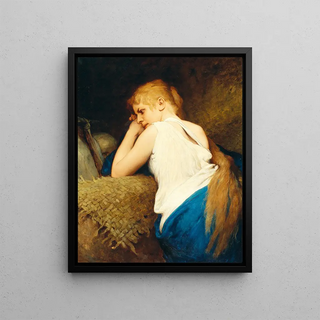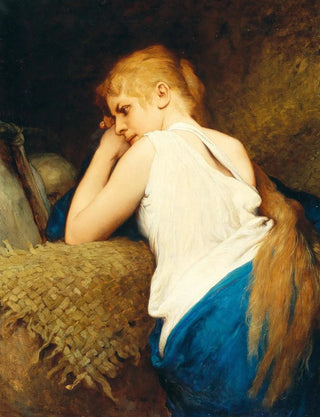Art print | Marie-Madeleine - Gabriel von Max


View from behind

Frame (optional)
Marie-Madeleine - Gabriel von Max – Engaging Introduction
The artwork "Marie-Madeleine" by Gabriel von Max immerses us in a universe where spirituality and human emotion intersect. This painting, emblematic of the late 19th century, embodies the quest for truth and redemption through the intense gaze of its subject. The depiction of Marie-Madeleine, often seen as a controversial figure, is here elevated by the artist's talent. By examining the details of this piece, one uncovers a world rich in symbolism and psychological depth, where each brushstroke seems to whisper the secrets of the human soul.
Style and uniqueness of the artwork
Gabriel von Max's style is distinguished by a harmonious blend of realism and symbolism, creating an atmosphere that is both tangible and mystical. In "Marie-Madeleine," light plays a leading role, illuminating the protagonist's face with an almost angelic softness. The delicate shadows surrounding her accentuate her expression of melancholy and contemplation. Max employs a warm color palette, evoking an intimacy that invites the viewer to approach the subject's inner world. The meticulous details, such as the textures of the clothing and the blurred background, enhance the sense of depth, guiding the gaze toward a rich emotional inner landscape. This artwork does not merely depict a biblical figure; it also explores universal themes such as suffering, redemption, and self-discovery.
The artist and his influence
Gabriel von Max, born in 1840 in Bohemia, is a major figure in Austrian art. Influenced by the Symbolist movement, he established himself through an innovative approach that combines psychology and spirituality. His works, often centered on religious or mythological themes, reflect a profound reflection on the human condition. Max was also a passionate advocate for art as a means of personal expression, promoting the idea that the artist should be a witness to their era. His influence extends beyond his own work, inspiring many contemporary artists to explore similar subjects. By examining "Marie-Madeleine," one can perceive the legacy of

Matte finish

View from behind

Frame (optional)
Marie-Madeleine - Gabriel von Max – Engaging Introduction
The artwork "Marie-Madeleine" by Gabriel von Max immerses us in a universe where spirituality and human emotion intersect. This painting, emblematic of the late 19th century, embodies the quest for truth and redemption through the intense gaze of its subject. The depiction of Marie-Madeleine, often seen as a controversial figure, is here elevated by the artist's talent. By examining the details of this piece, one uncovers a world rich in symbolism and psychological depth, where each brushstroke seems to whisper the secrets of the human soul.
Style and uniqueness of the artwork
Gabriel von Max's style is distinguished by a harmonious blend of realism and symbolism, creating an atmosphere that is both tangible and mystical. In "Marie-Madeleine," light plays a leading role, illuminating the protagonist's face with an almost angelic softness. The delicate shadows surrounding her accentuate her expression of melancholy and contemplation. Max employs a warm color palette, evoking an intimacy that invites the viewer to approach the subject's inner world. The meticulous details, such as the textures of the clothing and the blurred background, enhance the sense of depth, guiding the gaze toward a rich emotional inner landscape. This artwork does not merely depict a biblical figure; it also explores universal themes such as suffering, redemption, and self-discovery.
The artist and his influence
Gabriel von Max, born in 1840 in Bohemia, is a major figure in Austrian art. Influenced by the Symbolist movement, he established himself through an innovative approach that combines psychology and spirituality. His works, often centered on religious or mythological themes, reflect a profound reflection on the human condition. Max was also a passionate advocate for art as a means of personal expression, promoting the idea that the artist should be a witness to their era. His influence extends beyond his own work, inspiring many contemporary artists to explore similar subjects. By examining "Marie-Madeleine," one can perceive the legacy of






